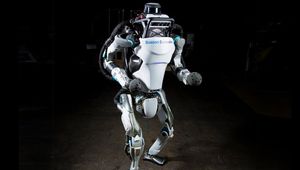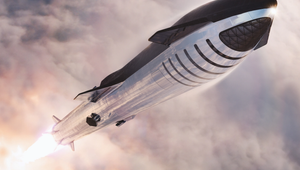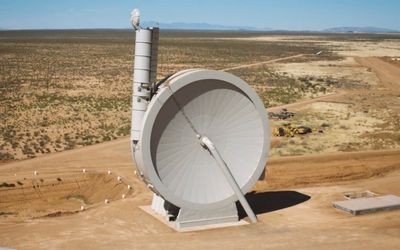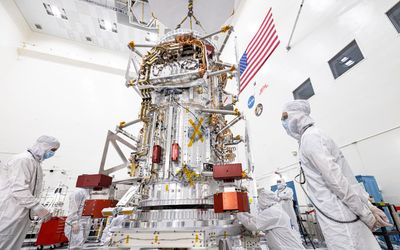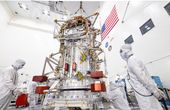Falcon Heavy Block 5
Reusable two-stage rocket with 3 boosters for safe transport of heavier payload into orbit
Technical Specifications
| OVERVIEW | |
| Height | 70 m / 229.6 ft |
| Diameter | 12.2 m / 39.9 ft |
| Mass | 1,420,788 kg / 3,125,735 lb |
| Payload To LEO | 63,800 kg / 140,660 lb |
| Payload To GTO | 26,700 kg / 58,860 lb |
| Payload To Mars | 16,800 kg / 37,040 lb |
| FIRST STAGE – 1 CENTER, 2 BOOSTER | |
| Height | 42.6 m / 140 ft |
| Diameter | 3.66 m / 12 ft |
| Empty Mass | 22,200 kg / 49,000 lb |
| Fueled Mass | 433,100 kg / 955,000 lb |
| Structure Type | LOX tank: monocoque |
| Fuel tank: skin and stringer | |
| Structure Material | Aluminum lithium skin; aluminum domes |
| Landing Legs | Number: 4 |
| Material: carbon fiber; aluminum honeycomb | |
| Number Of Merlin Engines | 27 (9 each core) |
| Oxidizer/Fuel | LOX / RP-1 |
| Thrust (sea level) | 22,819 kN / 5,130,000 lbf |
| Specific Impulse (sea level) | 282 sec / 2.77 km/s |
| Center - Burn Time | 187 sec |
| Booster – Burn Time | 154 seconds |
| Ascent Attitude Control - Pitch, Yaw | Gimbaled engines |
| Ascent Attitude Control - Roll | Gimbaled engines |
| Coast/Descent Attitude Control | Nitrogen gas thrusters and grid fins |
| SECOND STAGE | |
| Height | 12.6 m / 41 ft |
| Diameter | 3.66 m / 12 ft |
| Empty Mass | 4,000 kg / 8,800 lb |
| Fueled Mass | 111,500 kg /246,000 lb |
| Structure Type | LOX tank: monocoque |
| Fuel tank: skin and stringer | |
| Structure Material | Aluminum lithium skin; aluminum domes |
| Number Of Merlin Engines | 1 vacuum |
| Oxidizer/Fuel | LOX / RP-1 |
| Thrust (vacuum) | 981 kN / 220,500 lb |
| Specific Impulse (vacuum) | 348 sec / 3.41 km/s |
| Burn Time | 397 sec |
| Ascent Attitude Control - Pitch, Yaw | Gimbaled engine and nitrogen gas thrusters |
| Ascent Attitude Control - Roll | Nitrogen gas thrusters |
| Coast/Descent Attitude Control | Nitrogen gas thrusters |
| PAYLOAD - FAIRING | |
| Height | 13.1 m / 43 ft |
| Diameter | 5.2 m / 17.1 ft |
| ENGINES – MERLIN – SEA LEVEL | |
| Model | Merlin-1D++ |
| Oxidizer/Fuel | LOX / RP-1 |
| Thrust | 845 kN / 190,000 lbf |
| Nozzles | Gimbaled, 16:1 expansion |
| ENGINES – MERLIN – VACUUM | |
| Model | Merlin-1DV+ |
| Oxidizer/Fuel | LOX / RP-1 |
| Thrust | 981 kN / 220,500 lbf |
| Nozzles | Gimbaled, 165:1 expansion |
Overview
Overview
Falcon Heavy was designed and manufactured by SpaceX as a heavy-lift launch vehicle derived from the Falcon 9. It is a partially reusable composite rocket with a reinforced Falcon 9 first stage as the central core, and two added first stages as side boosters. It employs the identical second stage and payload fairing as Falcon 9.
Problem / Solution
Access to space is a complex and costly endeavor. Governments and private companies worldwide have struggled with the impracticality of building an expensive rocket for a single mission.
SpaceX's Falcon Heavy is a reusable, two-stage rocket based on the Falcon 9 design with two additional boosters. It is designed and built for the reliable and safe transportation of heavier cargo into Earth’s orbit. After transporting the payload into orbit, the first-stage central and outer boosters will withstand reentry to Earth, land safely, and be prepared for the next launch with minimal refurbishing. Similar to the Falcon 9, the first stage boosters undergo a strict inspection for any damages, replacement of some individual parts, and a pre-launch static fire of all 27 Merlin engines before its next launch. Since the rocket's most valuable and expensive parts are reused, Falcon Heavy substantially reduces space access costs for heavy cargo.
Flight Sequence
The Falcon Heavy takes off at full thrust of the center core and side boosters. The 27 gimbal-mounted engines handle pitch, yaw, and roll control. After a few seconds at full throttle by the center core, it throttles down to conserve fuel and prolong burn time. Once the side boosters burn for 154 seconds at maximum thrust and separate from the core, the center core resumes full thrust. The two booster cores perform a flip maneuver to reorient themselves using their cold gas thrusters and begin their descent to Earth. The center core burns for 187 seconds before it is ejected. Following the separation of the central core, the second stage ignites and transports the payload to a parking orbit before igniting again to place it in its final orbit. The payload fairing is ejected once positioned in its final orbit, and shortly after the reignition of the second stage.
The following process is the same as the Falcon 9 except with two additional boosters. The ejected central core also executes a flip maneuver to reorient itself using its cold gas thrusters. The three first stage cores fly to land or a drone ship using a combination of reaction control thrusters, forward-mounted grid fins, and thrust from one or three of the main Merlin engines. The engines perform a "boostback burn" to bring trajectory toward the landing site, deploy grid finds, "entry burn" to slow down the first stage, aerodynamic guidance, and then "landing burn" for a precise landing as it deploys landing legs and lands upright.
Design
The Falcon Heavy comprises four main components: the first stage rocket with one central core and two boosters, the interstage, the second stage rocket, and the payload fairing.
First Stage
The first stage of the Falcon Heavy is three Falcon 9 first stages with reinforced cores. The side boosters are linked to the center core at the nosecone, the interstage, and octaweb.
The center core has thicker tank walls and the booster separation system, while the two boosters are structurally identical.
Each core comprises nine Merlin gimbaled engines for a total of 27, and aluminum-lithium alloy tanks containing high-density subcooled liquid oxygen (LOX) and chilled rocket-grade kerosene (RP-1) propellant. Its primary purpose is to ascend to orbit with a high thrust to carry a heavier payload. Falcon Heavy's first stage at sea level generates around 22,819 kilonewtons of thrust. The engines are configured with eight engines surrounding a center engine called the “Octaweb” pattern. This pattern reduces the booster’s length and weight, and simplifies the rocket’s design and assembly. These engines also reorient the first stage cores before reentry and decelerate the vehicle in preparation for landing on a drone ship or in a specific location on land.
The Falcon Heavy first stage cores have four landing legs each and are made of advanced aluminum honeycomb carbon fiber sheet. They are stowed symmetrically around the first stage's base and deploy just before landing.
Second Stage
The second stage of Falcon Heavy is similar to the Falcon 9 second stage. It has a single Merlin Vacuum Engine and aluminum-lithium alloy tanks containing the same propellant as the first stage. Its primary purpose is to deliver Falcon Heavy’s big payload to the desired orbit. Falcon Heavy's second stage in vacuum generates around 981 kilonewtons of thrust. The second stage engine ignites shortly after stage separation and can be reignited many times to position multiple payloads into different target orbits. It also uses cold nitrogen gas (GN2) attitude control system (ACS) for a more reliable pointing and roll control.
Interstage
The interstage is a composite structure that joins the center core and second stage. Its primary purpose is to allow the separation of the first and second stage mid-flight with its pneumatic pushers. Four hypersonic titanium grid fins on each booster are positioned at the interstage’ base or nosecone to orient the rocket during reentry by shifting the center of pressure.
Payload Fairing
The payload fairing houses and protects the cargo during the mission. The fairing is made of carbon composite material to safeguard satellites as they travel into orbit. It is ejected after being positioned at the target orbit and is recovered for reuse on future missions.
Merlin Engines
The Merlin rocket engines are specifically developed for recovery and reuse features of the Falcon series of launch vehicles. These engines are gimbaled and have throttle and restart capability for high degrees of control. Two of the nine Merlin engines in any boosters of the Falcon Heavy can malfunction without affecting the launch. Merlin engines utilize chilled rocket-grade kerosene (RP-1) and subcooled liquid oxygen as rocket propellants in an open-cycle or gas-generator power cycle. A Turbopump feed system feeds the propellant, heated helium pressurizes the fuel tank, and dual redundant triethylaluminum-triethylborane (TEA-TEB) pyrophoric igniters for restart reliability.
The two engines used in the Falcon Heavy are the Sea Level Merlin engine and the Vacuum Merlin engine. The Sea Level Merlin engines with a smaller exhaust section and 16:1 expansion nozzle primarily for ascent from Earth are used in the first stages of Falcon Heavy. The Vacuum Merlin engine used in the second stage has a larger expansion nozzle of 165:1 and a bigger exhaust section to maximize efficiency in the vacuum. The combustion chamber is cooled by regenerative cooling, while the expansion nozzle is by radiative cooling.
